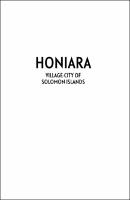Honiara
Village-City of Solomon Islands
Abstract
Nahona`ara—means 'facing the `ara', the place where the southeast winds meet the land just west of Point Cruz. Nahona`arabecame Honiara, the capital city of Solomon Islands with a population of 160,000, the only significant urban centre in a nation of 721,000 people. Honiara: Village-City of Solomon Islands views Honiara in several ways: first as Tandai traditional land; then as coconut plantations between the 1880s and 1930s; within the British protectorate (1893–1978) and its Guadalcanal District; in the 1942–45 war years, which created the first urban settlement; in the directly post-war period until 1952 as the new capital of the protectorate, replacing Tulagi; and then as the headquarters of the Western Pacific High Commission (WPHC) between 1953 and 1974. Finally, in 1978, Honiara became the capital of the independent nation of Solomon Islands and the headquarters of Guadalcanal Province. The book argues that over decades there have been four and sometimes five changing and intersecting Honiara ‘worlds’ operating at one time, each of different social, economic and political significance. The importance of each group—British, Solomon Islanders, other Pacific Islanders, Asians, and more recently the 2003–17 presence of the Regional Assistance Mission to Solomon Islands (RAMSI)—has changed over time.
Keywords
Solomon Islands; Honiara; Guadalcanal; Urbanization; development studiesDOI
10.22459/H.2022ISBN
9781760465070, 9781760465063, 9781760465070Publisher
ANU PressPublisher website
https://press.anu.edu.au/Publication date and place
Canberra, 2022Imprint
ANU PressSeries
Pacific Series,Classification
Australasian and Pacific history


 Download
Download